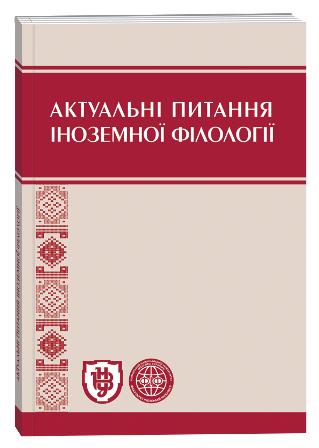THE POTENTIAL OF THE LINGUOSEMIOTIC INTERPRETATION FOR THE ANALYSIS OF THE IMMIGRATION ACT GENRE IN THE US LEGAL DISCOURSE
DOI:
https://doi.org/10.32782/2410-0927-2023-18-1Keywords:
legal discourse, genre, immigration act, legal linguosemiotics, linguosemiotic interpretationAbstract
The present paper seeks to outline a theoretical framework for the study of the genre of the immigration act in the legislative discourse of the USA and is structured in accordance with the main points that it aspires to clear up. Firstly, the fundamental genre features of the immigration act are singled out: 1) agency, which is revealed in semiosis - the process in which the text of the act functions as a sign; 2) sociality, which results from the agency of law as any legal action is socially determined; 3) genre markedness of the code, informational and cultural dimensions of semiosis of the immigration acts. The third feature is manifested in the parameterization of the genre of the act as a repeated functional unity of signs, which implies a) stability of linguistic coding (code dimension); b) determination of the content by the needs of society (informational dimension); c) compliance with the legal system and the existing social institution of law (cultural dimension). Secondly, it is claimed that the genre of the immigration act presents one of the research objects in legal linguosemiotics. The latter is proposed to be singled out as a separate subdivision of linguosemiotics. It is argued that a fundamental method of genre research in legal linguosemiotics is linguosemiotic interpretation, which is aimed at a) the description of key genre-shaping codes (key legal terms) used by legislators to make the objective world accessible; b) the establishment of the “syntagms” formed by key codes and other codes determined by the subject of enactment; c) the description of the location of the immigration act in the space of the US legal culture. Thirdly, the paper suggests the canons which the linguosemiotic interpretation should be grounded upon a) the canon of the determination of the interpretation by the needs of society (the model of legal reality); b) the canon of the integrity of the object of interpretation; c) the canon of the completeness of the interpretation.
References
Андрейчук Н. Виміри семіозису: монографія. Львів: ПАІС, 2021. 352 с.
Андрейчук Н. Семіотика лінгвокультурного простору Англії кінця XV – початку XVIII століття: монографія. Львів: Вид-во Львів. Політехніки, 2011. 280 с.
Балинська О. Семіотика права: монографія. Львів: ЛьвДУВС, 2013. 416 с.
Бацевич Ф.С. Лінгвістична генологія: проблеми і перспективи. Львів: ПАІС, 2005. 264 с.
Дзера Оксана. Біблійна інтертекстуальність і переклад: англо-український контекст: монографія. Львів: ЛНУ імені Івана Франка, 2017. 490 с.
Етимологічний словник української мови: у 7 т. / Ін-т мовознавства ім. О. О. Потебні НАН України. Т. 2: Д-Копці. Київ: Наук. думка, 1985. 572 с.
Кравченко Н. К. Міжнародно-правовий дискурс: когнітивно-комунікативний аспект: дис. на здобуття наук. ступеня докт. філол. наук : спец. 10.02.15 «Загальне мовознавство». Київський національний університет імені Тараса Шевченка, Київ, 2007.
Помірко Р., Бацевич Ф., Паславська А. Мовленнєві жанри в міжкультурній комунікації: монографія. Львів: ПАІС, 2010. 218 с.
Просяна А.В. Мовленнєві жанри законодавчого юридичного дискурсу. Вісник ОНУ. Сер.: Філологія, 2018. Т. 23, вип. 2 (18). С. 87−95.
Філософський енциклопедичний словник / гол. ред. В. І. Шинкарук. К.: Абрис, 2002. 742 с.
Яхонтова Т.В. Лінгвістична генологія наукової комунікації: монографія. Львів: Видавничий центр ЛНУ імені Івана Франка, 2009. 420 с.
Betti E. On a General Theory of Interpretation: The Raison d'Etre of Hermeneutics. The American Journal of Jurisprudence, 1987. Vol. 32, Issue 1. P. 245–268.
Bhatia V. K. Analyzing Genre: Language Use in Professional Settings. London: Routledge, 1993. 264 p.
Bhatia V. K. Critical Genre Analysis: Investigating Interdiscursive Performance in Professional Contexts. London, New York, Routledge, 2017. 232 p.
Bhatia V. K. Critical reflections on genre analysis. Iberica 24, 2012. P. 17–28.
Bhatia V. K. Worlds of Written Discourse: A genre-based view, London and New York: Continuum, 2004. P. xvii + 228.
Eco U. Semiotics and the Philosophy of Language. Bloomington: Indiana University Press, 1984. 242 p.
Genre and the New Rhetoric / ed. by A. Freedman, P. Medway. London: Taylor and Francis, 1994. 254 p.
Halliday M. A. K. Language as social semiotic: The social interpretation of language and meaning. Maryland: University Park Press, 1978. 256 p.
Hasan R. The structure of a text. Language, Context and Text / M. A. K. Halliday and R. Hasan (eds). Geelong, Victoria: Deakin University Press, 1985. P. 52–69.
Heidegger M. Letter on Humanism. Basic Writings / David Farrell Krell ed. New York: Harper& Row, 1977. P. 190–242.
Martin J. R. Process and text: Two aspects of human semiosis. Systemic Perspective on Discourse, Vol. 1: Selected Theoretical Papers from the 9th International Systemic Workshop. / J. D. Benson and W. S. Greaves (eds), Norwood, NJ: Alex, 1985, P. 248–274.
Martin, J. R. Language, register and genre. Children Writing: Reader / F. Christie (ed.). Geelong: Deakin University Press, 1984. P. 21–30.
Miller C. R. Genre as social action. Quarterly Journal of Speech, 70, 1984. P. 151–167.
Morris Ch. Foundations of the Theory of Signs. International Encyclopedia of Unified Science, 1938, Vol. 1, Number 2. P. 1–59.
Steiner P. Semiotics. International Encyclopedia of Communications in 4 volumes / ed. in Chief E Barnouw. Oxford, New York: Oxford University Press, 1989. Vol. 4 (Sapi – Zwor). P. 46−50.
Swales J.M. Genre Analysis. English in Academic and Research Settings. Cambridge: Cambridge University Press, 1990. 260 p.
Wittgenstein L. Tractatus Logico-Philosophicus / Trans. by D.F.Rears and B.F. McGuinness. With an introduction by Bertrand Russell. London, New York: Routledge, 2002. 106 p.







